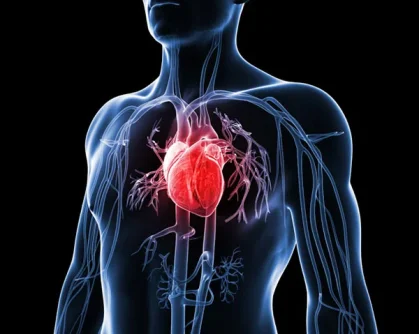Nelson Vergel
Founder, ExcelMale.com

D'Andrea A, Limongelli G, Morello A, et al.
Anabolic-androgenic steroids and athlete's heart: When big is not beautiful...!
Int J Cardiol 2015;203:486-8. http://www.sciencedirect.com/science/article/pii/S0167527315307506
Anabolic–androgenic steroids (AASs) are synthetic derivatives of testosterone. Their abuse has been linked with numerous toxic and hormonal effects (1–5). In particular, although data are conflicting, healthy athletes abusing AAS may show increased levels of low-density lipoproteins and low levels of high-density lipoproteins, elevated systolic and diastolic arterial blood pressure values and left ventricular (LV) hypertrophy that may persist even after AAS cessation (5–7).
We describe the case of a 35-year-old bodybuilder with a 20-year history of strength training, presenting with increasing exertional dyspnoea and fatigue during mild dynamic effort. The athlete revealed a more than 15-year history of illicit use of supraphysiologic doses of AAS (weekly dose of 675 mg of testosterone-equivalent).
Patient's past medical history was negative for cardiac disease, and he had a normal physical examination (body surface area: 1.9m2). Resting blood pressure was within normal limits. The laboratory tests showed normal liver and renal functions and serum electrolytes, normal creatine phosphokinase and thyroid functions, and elevated low density lipoprotein values.
Resting ECG showed LV hypertrophy with widespread abnormalities of ventricular repolarization and a ventricular ectopic beats. Standard transthoracic echocardiography demonstrated severe concentric LV hypertrophy (septal wall thickness: 17 mm; posterior wall thickness: 13.5 mm), with mildly impaired systolic function (ejection fraction by Simpson biplane: 50%). There was no LV outflow tract obstruction at rest or after Valsalva maneuver.
Conversely, transmitral flow pattern showed an impairment of global and regional diastolic functions, with a mean E/Ea ratio of 14. By speckle tracking strain analysis, a severe and diffuse impairment of both radial and longitudinal myocardial deformation was evidenced.
Cardiopulmonary exercise test revealed severe reduction of functional capacity: maximal watts reached 100 (65% of target); maximal VO2 24.9 ml/kg/min (50% of target); VE/VCO2 slope 31; and VO2/work 7.
Cardiac magnetic resonance confirmed severe LV hypertrophy, revealing also focal areas of delayed enhancement with pattern of nonischemic distribution localized at the level of septal and inferior-lateral wall of the left ventricle.
After 6 months from discontinuation of steroids, the athlete showed by cardiac magnetic resonance a mild reduction of LV volumes and hypertrophy, with improvement of speckle-tracking measurements by echocardiography and a better functional capacity by cardiopulmonary test: maximal watts reached 125 (71% of target); maximal VO2 31.8 ml/kg/min (65% of target); VE/VCO2 slope 29; VO2/ work 10.
Athletes abusing AAS often exhibit severe LV hypertrophy. However, since physiologic LV hypertrophy may be related to the increased afterload typical of isometric exercise (1) the adequate cardiac evaluation of elite athletes who admit chronic AAS abuse can be really complex (8–10). Possible associations between AAS and LV hypertrophy can be related to secondary arterial hypertension or to a direct effect on the myocardium.
Notably, studies in isolated human myocytes have shown that AASs bind to androgen receptors and may directly cause hypertrophy (2–3), potentially via tissue up-regulation of the renin– angiotensin system (4). Indeed, clinical studies suggest a distinct form of LV hypertrophy in AAS abusers, with textural changes in the myocardium on echocardiography before the onset of overt LVH (5–7).
The present case illustrates that several years after chronic abuse of AAS, strength athletes can show LV hypertrophy with a sub-clinical impairment of both systolic and diastolic myocardial functions, strongly associated with mean dosage and time duration of AAS use.
The combined use of standard echocardiography, speckle-tracking strain and cardiac magnetic resonance may be useful for early identification of patients with more diffused cardiac involvement, and eventually to investigate the reversibility of such myocardial effect after discontinuation of the drug in AAS users.
References
Ø [1] J. Payne, P.J. Kotwinski, H.E. Montgomery, Cardiac effects of anabolic steroids, Heart 90 (2004) 473–475.
Ø [2] S. Nottin, L.-D. Nguyen, M. Terbah, P. Obert, Cardiovascular effects of androgenic anabolic steroids in male bodybuilders determined by tissue Doppler imaging, Am. J. Cardiol. (2006).
Ø [3] L. Fanton, D. Belhani, F. Vaillant, A. Tabib, L. Gomez, J. Descotes, et al., Heart lesions associated with anabolic steroid abuse: comparison of post-mortem findings in athletes and norethandrolone-induced lesions in rabbits, Exp. Toxicol. Pathol. (2009).
Ø [4] P.D. Thompson, A. Sadaniantz, E. Cullinane, K. Bodziony, D. Catlin, G. Torek-Both, et al., Left ventricular function is not impaired in weight-lifters who use anabolic steroids, J. Am. Coll. Cardiol. (1992) 19.
Ø [5] N.A. Hassan, M.F. Salem, M.A.E.L. Sayed, Doping and effects of anabolic androgenic steroids on the heart: histological, ultrastructural, and echocardiographic assessment in strength athletes, Hum. Exp. Toxicol. (2009).
Ø [6] J. Marsh, M.H. Lehmann, R.H. Ritchie, J.K.Gwathmey, G.E. Green, R.J. Schiebinger, Androgen receptors mediate hypertrophy in cardiac myocytes, Circulation 98 (1998) 256–261.
Ø [7] P. Liu, A.K. Death, D.J. Handelsman, Androgens and cardiovascular disease, Endocr. Rev. 24 (2003) 313–340.
Ø [8] A. D'Andrea, P. Caso, G. Salerno, R. Scarafile, G. De Corato, C. Mita, et al., Left ventricular early myocardial dysfunction after chronic misuse of anabolic androgenic steroids: a Doppler myocardial and strain imaging analysis, Br. J. Sports Med. 41 (3) (2007) 149–155.
Ø [9] S. Sharma, Athlete's heart—effect of age, sex, ethnicity and sporting discipline, Exp. Physiol. 88 (2003) 665–669.
Ø [10] M. Galderisi, N. Cardim, A. D'Andrea, O. Bruder, B. Cosyns, L. Davin, et al., The multimodality cardiac imaging approach to the Athlete's heart: an expert consensus of the European Association of Cardiovascular Imaging, Eur. Heart J. Cardiovasc. Imaging 16 (4) (2015) 353.












